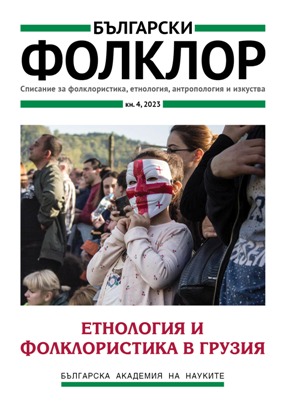Религиозност в трансформация: народни и нормативни религиозни практики в Източна Грузия
Religiosity in Transformation: Vernacular and Normative Religious Practices in East Georgia
Author(s): Ketevan KhutsishviliSubject(s): Christian Theology and Religion, History, Anthropology, Social Sciences, Theatre, Dance, Performing Arts, Language and Literature Studies, Archaeology, Fine Arts / Performing Arts, Cultural history, Museology & Heritage Studies, Semiotics / Semiology, Customs / Folklore, Architecture, History of Church(es), Geography, Regional studies, Library and Information Science, Visual Arts, Human Geography, Regional Geography, Preservation, Theoretical Linguistics, Sociology, Ethnohistory, History of ideas, Local History / Microhistory, Social history, Special Historiographies:, Theology and Religion, Comparative Studies of Religion, Morphology, Lexis, Semantics, Pragmatics, Historical Linguistics, Cultural Anthropology / Ethnology, Culture and social structure , Social development, Social differentiation, Sociology of Culture, History of Communism, Post-Communist Transformation, Eastern Orthodoxy, Philology, Social Norms / Social Control, Sociology of Religion, History of Religion, Identity of Collectives, Psychology of Religion
Published by: Институт за етнология и фолклористика с Етнографски музей при БАН
Keywords: vernacular practices; religiosity; hybridity; transformations; Georgia
Summary/Abstract: Georgian everyday life is highly tied up with the rich religious traditions that have been developed as a result of the centuries-long synthesis of pre-Christian and Christian practices and worldviews. The Soviet period caused the fragmentation of the traditional religious knowledge and the practice moved to the household level and was paganized. In the post-Soviet period, the burst of religious sentiments and search for identity increased the involvement of big masses to religious practices. The transformations were accompanied by a process of individualization of religion, which has led to a change of forms of religiosity. Based on the ethnographic data of East Georgia, the article discusses the correlation of the normative, vernacular and resistant forms of religiosity. Historical-comparative and parallel analyses are used to research two examples of religious practice: Lomisoba and Berikaoba. Lomisoba is analyzed as an example of hybrid, massive, collective holiday. Berikaoba is more local, not connected to a sacred site, performative festival. It is argued that the contemporary processes are having an impact on the religiosity and the religiosity of certain groups is trying to be defined in new forms. All the old and new forms of religiosity are explicitly displayed and played out in contemporary Georgia. At the same time there are some hidden, or rather implicit practices.
Journal: Български фолклор
- Issue Year: XLIX/2023
- Issue No: 4
- Page Range: 572-588
- Page Count: 17
- Language: Bulgarian
- Content File-PDF

